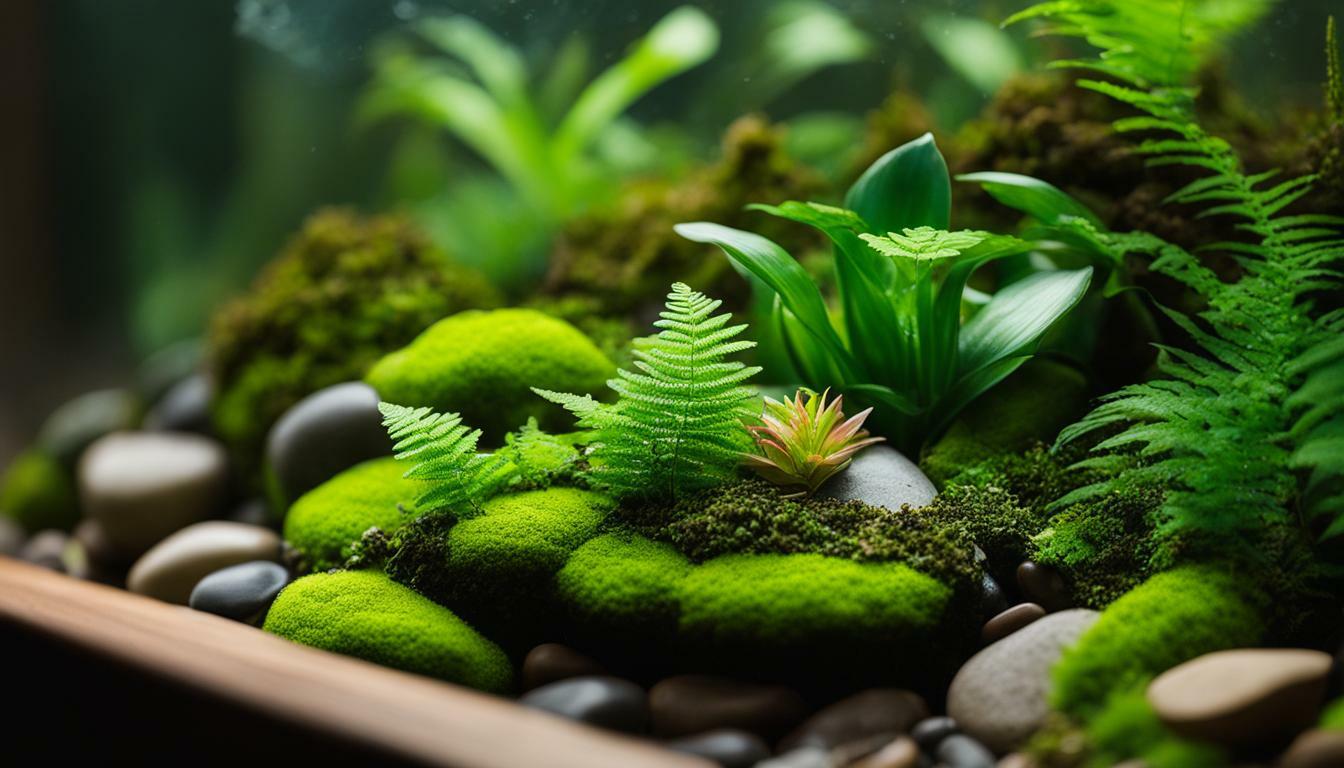Welcome to the ultimate guide on caring for terrarium plants mosses. If you’re a beginner or an experienced terrarium enthusiast, this guide will provide you with all the information you need to create a thriving green space in your home.
Terrariums are a wonderful way to bring nature indoors and create a mini-ecosystem right in your own home. Whether you have a green thumb or are just starting out, this guide will walk you through the process of selecting the perfect terrarium plants mosses, offering tips and advice along the way.
Key Takeaways:
- Indoor terrarium plants are a great choice for bringing nature into your home.
- Low light terrarium plants are perfect for spaces with limited natural light.
- Terrarium plants for beginners are easy to care for and require minimal maintenance.
- Understanding the different types of terrarium plants will help you select the best options for your terrarium.
- Terrarium mosses add visual appeal and can be used creatively to enhance your terrarium landscape.
Now, let’s dive into the world of terrarium plants mosses and discover how to create a beautiful and thriving green space in your home.
Types of Terrarium Plants: Choosing the Perfect Selection
When it comes to choosing the right terrarium plants mosses, there are various options to consider. Whether you prefer indoor plants, low light varieties, or are a beginner looking for easy-to-maintain options, this section will guide you through the process of selecting the perfect plants for your terrarium.
Indoor terrarium plants are a popular choice for those who want to bring a touch of nature into their homes. These plants thrive in the controlled environment of a terrarium and can tolerate lower light conditions. Some popular indoor terrarium plants include the Peace Lily, Pothos, and Spider Plant. These plants not only add beauty to your terrarium but also help purify the air and create a healthier indoor environment.
If you have a terrarium in a room with limited natural light, you’ll need to choose low light terrarium plants. These plants are specifically adapted to thrive in low light conditions and require little maintenance. Some examples of low light terrarium plants include the Snake Plant, ZZ Plant, and Cast Iron Plant. These plants are known for their ability to tolerate a wide range of light conditions, making them perfect for terrariums placed in dimly lit areas.
For beginners, it’s important to choose terrarium plants that are easy to care for. These plants require minimal attention and can withstand a few mistakes while you’re learning the ropes of terrarium care. Some popular terrarium plants for beginners include the Fittonia, Baby Tears, and Haworthia. These plants have simple care requirements and are forgiving if you miss a watering or two.
Table 1: Examples of terrarium plants for different preferences
| Preference | Examples |
|---|---|
| Indoor plants | Peace Lily, Pothos, Spider Plant |
| Low light plants | Snake Plant, ZZ Plant, Cast Iron Plant |
| Plants for beginners | Fittonia, Baby Tears, Haworthia |
Remember, choosing the right terrarium plants mosses is essential for the success of your miniature garden. Consider factors such as light levels, maintenance requirements, and personal preferences when making your selections. With the right plants, your terrarium will thrive and become a stunning centerpiece in your home or office.
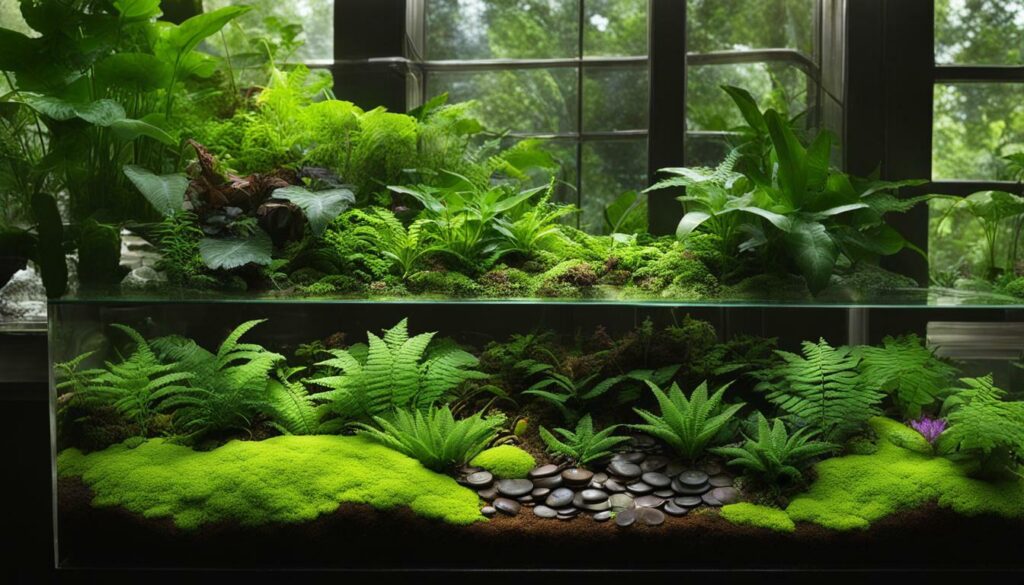
Proper care is crucial for the well-being of your terrarium plants mosses. In this section, we will explore essential care tips to help you maintain a healthy and thriving terrarium environment.
1. Substrate Choice: Choose a suitable substrate for your terrarium plants. A high-quality potting mix specifically formulated for terrariums is ideal, as it provides the necessary nutrients and drainage.
2. Watering: Proper watering is key to maintaining the right moisture levels in your terrarium. Avoid overwatering, as excess moisture can lead to root rot. Use a spray bottle or a watering can with a narrow spout to water directly around the base of the plants.
3. Humidity: Terrarium plants mosses thrive in humid environments. To increase humidity, mist the plants regularly or place a small dish of water inside the terrarium. Monitor the humidity levels using a hygrometer and adjust accordingly.
4. Lighting: Most terrarium plants mosses prefer bright, indirect light. Place your terrarium near a window with filtered sunlight or use artificial grow lights if natural light is limited.
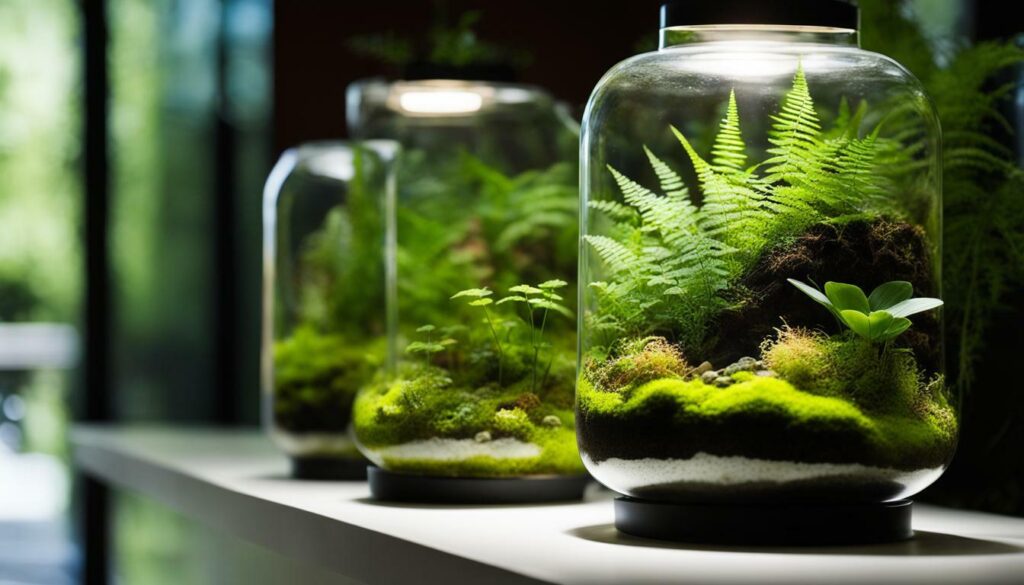
5. Ventilation: Proper airflow is essential to prevent the growth of mold and fungi in your terrarium. Open the terrarium occasionally to allow fresh air to circulate, but avoid exposing the plants to draughts or extreme temperature changes.
6. Preventing Pests: Keep a close eye on your terrarium plants for any signs of pests, such as aphids or mites. If you spot any, gently remove them by hand or use organic pest control methods. Quarantine any new plants before introducing them to the terrarium to prevent the spread of pests.
By following these care tips, you can create a flourishing terrarium environment for your plants to thrive. Remember to monitor and adjust the care routine based on the specific needs of your terrarium plants mosses.
Selecting the Perfect Terrarium Moss: Enhancing Visual Appeal
Terrarium mosses play a significant role in creating a visually stunning terrarium. In this section, we will explore the different types of mosses available and share tips on how to use them to enhance the overall aesthetic appeal of your terrarium.
When it comes to terrarium mosses, there are several types to choose from, each with its own unique characteristics. Some popular options include sheet moss, cushion moss, mood moss, and spikemoss. Sheet moss, also known as carpet moss, is a versatile choice that can be used to create a lush green carpet effect in your terrarium. Cushion moss, as the name suggests, forms small, cushion-like mounds and adds a textural element to your terrarium. Mood moss, with its feathery appearance, adds a whimsical touch to any terrarium. Spikemoss, on the other hand, features delicate foliage that cascades beautifully over rocks and other decorative elements.
To enhance the visual appeal of your terrarium, consider incorporating a variety of moss types. This will add depth and dimension to your terrarium and create an eye-catching display. For example, you can use sheet moss as a base layer to cover the floor of your terrarium, then add cushion moss on top of rocks or other elevated surfaces to create a natural-looking landscape. Mixing different moss types will also add visual interest and make your terrarium feel more dynamic.
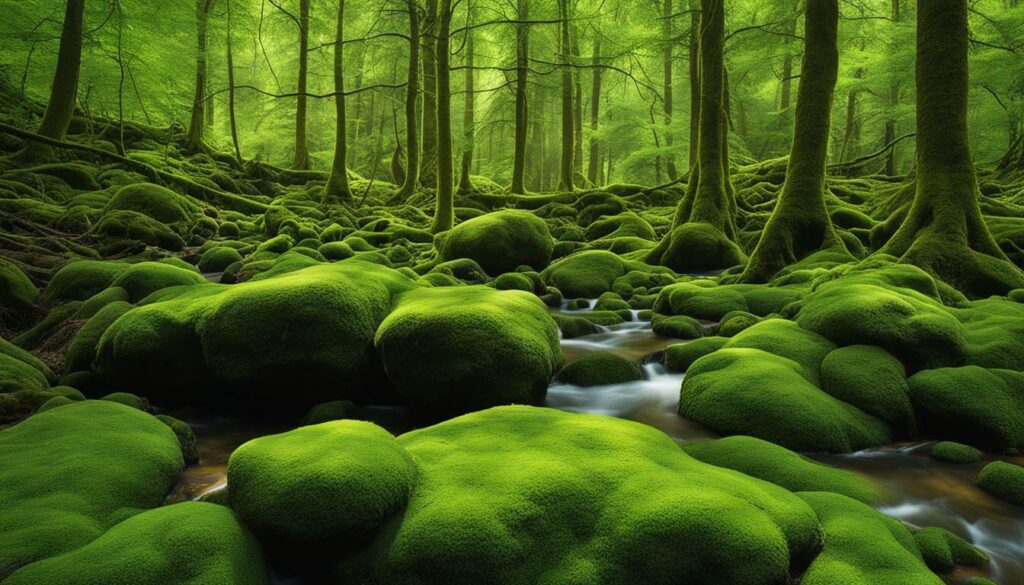
When using terrarium mosses, it’s important to ensure they receive the right amount of moisture and light. Most mosses prefer a moist environment but can be susceptible to rot if overwatered. Monitor the moisture levels in your terrarium and adjust watering accordingly. Additionally, place your terrarium in an area that receives indirect light or partial shade. Direct sunlight can cause the mosses to dry out or become scorched.
Enhancing your terrarium with mosses
- Choose a variety of moss types to create depth and dimension in your terrarium.
- Layer different moss types to create a natural-looking landscape.
- Monitor moisture levels and provide indirect light for optimal moss growth.
Where to buy terrarium mosses
If you’re looking to purchase terrarium mosses, there are several reputable online sources where you can find a wide selection. Some popular options include specialty terrarium plant nurseries, online marketplaces, and even botanical garden websites. Be sure to choose a source that offers high-quality mosses and provides detailed care instructions to ensure the success of your terrarium.
| Retailer | Website |
|---|---|
| Terrarium Garden | www.terrariumgarden.com |
| The Moss Emporium | www.mossemporium.com |
| Botanical Gardens Direct | www.botanicalgardensdirect.com |
By selecting the perfect terrarium mosses and using them effectively in your terrarium, you can create a visually stunning display that will be the envy of all who see it. Experiment with different moss types and arrangements to find the combination that best suits your style and preferences. With a little creativity and attention to care, your terrarium will thrive and become a beautiful focal point in your home or office.
Finding Terrarium Plants for Sale Online
If you’re looking to buy terrarium plants mosses, the online market offers a convenient and diverse range of options. In this section, we will explore some of the best online sources and platforms to find high-quality terrarium plants for your green space.
Online Nurseries
One of the best ways to find a wide variety of terrarium plants for sale is through online nurseries. These nurseries specialize in offering a vast selection of plants, including terrarium mosses, and often provide detailed information about each plant’s care requirements. Online nurseries also ensure that the plants are well-packaged for shipping, minimizing the risk of damage during transit.
| Nursery Name | Website |
|---|---|
| Green Thumb Terrariums | www.greenthumbterrariums.com |
| Tropical Oasis Nursery | www.tropicaloasisnursery.com |
| Exotic Plants Online | www.exoticplantsonline.com |
Marketplace Platforms
Another option for purchasing terrarium plants online is through marketplace platforms. These platforms connect individual sellers, offering a wide range of plants, including terrarium mosses, from different sellers within a single website. Popular marketplace platforms often have customer reviews and ratings, helping you make informed decisions about the quality and reliability of the seller.
- Etsy – www.etsy.com
- eBay – www.ebay.com
- Amazon – www.amazon.com – Check their “Live Plants” category for terrarium plants mosses.
When purchasing from marketplace platforms, it is essential to review the seller’s rating, read customer feedback, and inquire about their shipping and packaging practices to ensure the best possible experience and healthy plants upon arrival.
By exploring online nurseries and marketplace platforms, you can find a wide variety of terrarium plants mosses to enhance the beauty of your green space. Remember to check the specific care requirements of each plant and choose a reputable seller for a successful purchase. Happy terrarium gardening!
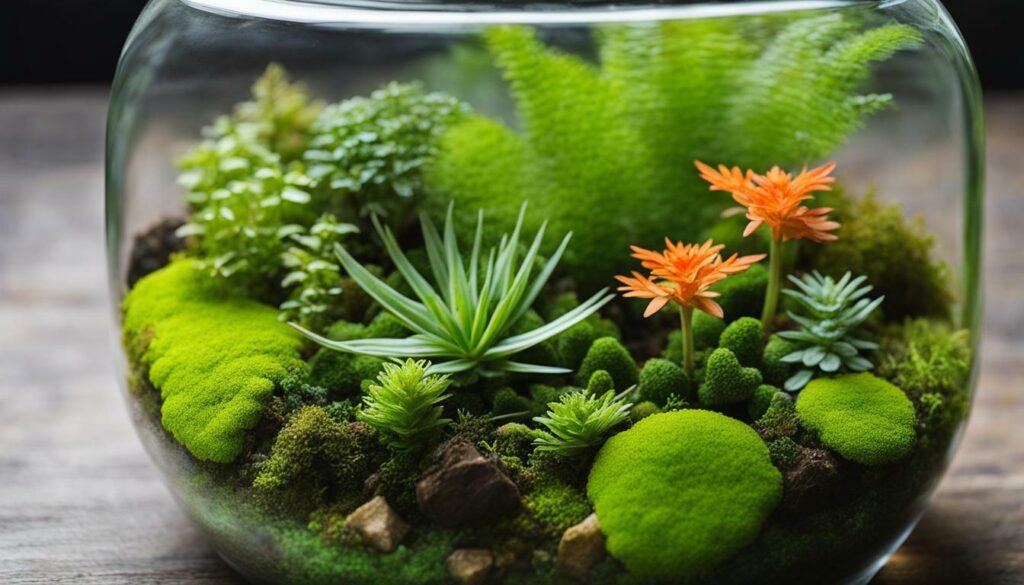
Designing a beautiful terrarium landscape is an art that requires careful consideration and planning. In this section, we will share valuable tips and ideas to help you create a captivating and visually stunning terrarium display using a combination of terrarium plants mosses.
One key aspect of designing a terrarium landscape is selecting the right combination of terrarium plants mosses. Consider incorporating a variety of plants with different textures, colors, and heights to create a visually appealing arrangement. For example, you can combine delicate ferns with vibrant mosses to add depth and contrast to your terrarium. Additionally, incorporating trailing plants that cascade over rocks or driftwood can add a sense of movement and intrigue.
To further enhance the visual appeal of your terrarium landscape, consider creating different levels or layers. You can achieve this by using rocks, pebbles, or other natural elements to create distinct areas within your terrarium. This not only adds visual interest but also mimics the natural habitat of the plants, creating a more authentic and immersive experience.
| Terrarium Plant Ideas | Type of Terrarium Plant |
|---|---|
| “Fairy Washboard” Moss | Miniature Moss |
| “Moonlight” Fern | Tropical Fern |
| “Pixie Point” Peperomia | Succulent |
Don’t be afraid to get creative with your terrarium design. Consider adding whimsical elements such as miniature figurines, decorative stones, or even small LED lights to create a magical and enchanting scene. Just be sure to choose elements that are safe for the plants and won’t disrupt their growth or health.
By following these tips and exploring your own creativity, you can design a terrarium landscape that not only showcases the beauty of terrarium plants mosses but also becomes a unique and captivating centerpiece in your home or office.
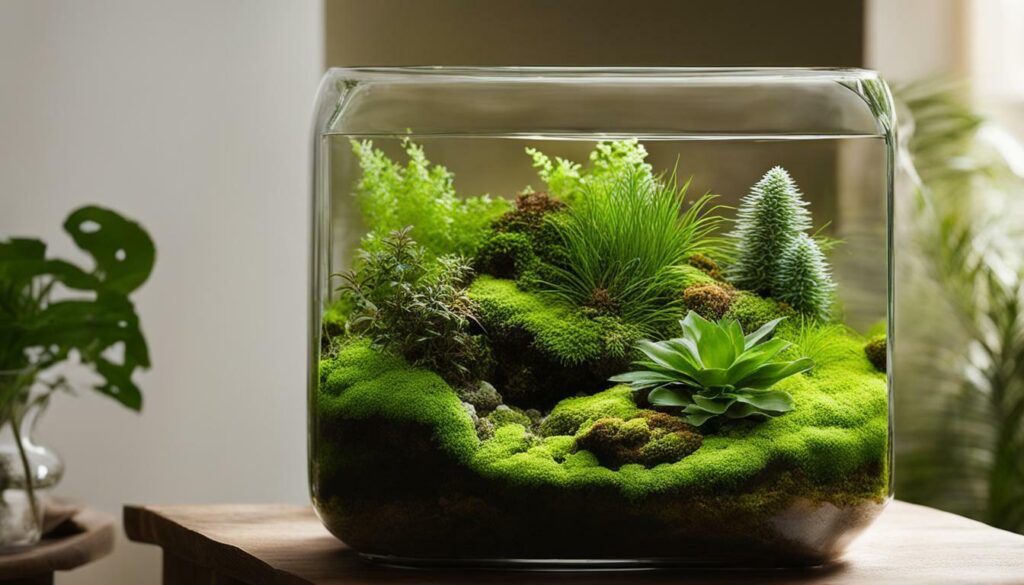
Preventing Condensation in Terrariums: Tips and Tricks
Condensation can be a common issue in terrariums, and if left unaddressed, it can negatively impact the health of your terrarium plants mosses. In this section, we will explore tips and tricks to help you prevent condensation and maintain optimal humidity levels in your terrarium.
Tip 1: Proper Ventilation
Ensuring adequate airflow is essential for preventing condensation in your terrarium. Be sure to choose a terrarium with proper ventilation, such as one with built-in vents or an open-top design. You can also open the terrarium for a short period each day to allow fresh air to circulate. Avoid placing your terrarium in a humid or stagnant area, as this can contribute to condensation buildup.
Tip 2: Use a Hygrometer
Monitoring the humidity levels inside your terrarium is crucial for preventing excess moisture. Invest in a hygrometer to accurately measure the humidity levels. Most terrarium plants mosses thrive in humidity ranging from 60-70%. If the humidity exceeds this range, consider using a dehumidifier or cracking open the terrarium for a short period to release excess moisture.
“Proper ventilation, monitoring humidity levels, and adjusting lighting can help prevent condensation in your terrarium and keep your plants healthy.”
Tip 3: Adjust Lighting
Lighting plays a significant role in the humidity levels of your terrarium. If you notice excessive condensation, consider adjusting the lighting to reduce heat and moisture buildup. Opt for lower wattage bulbs or increase the distance between the light source and your terrarium. Experiment with different lighting setups to find the ideal balance for your specific terrarium plants mosses.
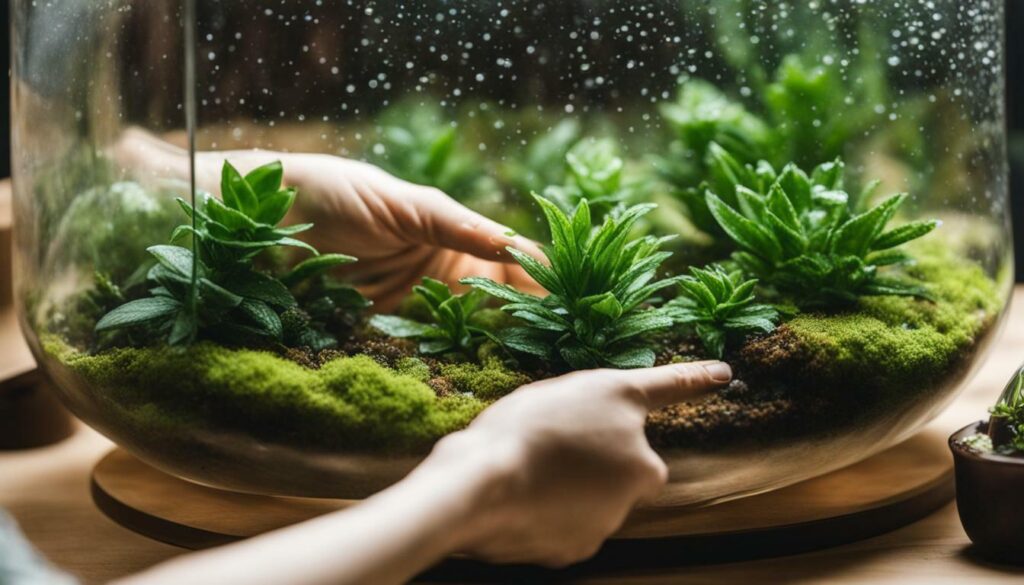
| Tips to prevent condensation: |
|---|
| Proper ventilation |
| Use a hygrometer to monitor humidity levels |
| Adjust lighting to reduce heat and moisture buildup |
By implementing these tips and tricks, you can effectively prevent condensation in your terrarium and create a healthy environment for your terrarium plants mosses. Remember to regularly monitor the humidity levels and make adjustments as needed. With proper care, your terrarium will flourish, and your plants will thrive.
Terrarium Plant Care for Beginners: Easy Steps to Success
If you’re new to terrariums and looking to embark on this rewarding journey, this section will guide you through the basics of terrarium plant care, providing you with easy steps to ensure success in maintaining your terrarium plants mosses.
First and foremost, it’s important to select the right terrarium plants for beginners. Opt for low-maintenance varieties that can thrive in the controlled environment of a terrarium. Some great options include ferns, succulents, and air plants. These plants are resilient and can tolerate fluctuations in humidity, light, and watering.
Once you’ve chosen your terrarium plants, it’s crucial to pay attention to their care requirements. Here are a few essential steps to follow:
- Choose the right terrarium: Select a container that suits the needs of your plants. Closed terrariums create a humid environment, while open terrariums allow for better airflow.
- Provide proper lighting: Most terrarium plants thrive in indirect light. Place your terrarium near a window but avoid exposing it to direct sunlight, as it can lead to heat buildup and damage the plants.
- Water sparingly: Overwatering is a common mistake in terrarium plant care. Allow the soil to dry out between waterings to prevent root rot. Use a spray bottle to mist the plants and maintain the right moisture level.
- Monitor humidity: Closed terrariums naturally create a humid environment, but if you have an open terrarium, mist the plants occasionally to increase humidity. You can also use a hygrometer to measure the humidity levels.
- Prune and groom: Regularly trim any dead or yellowing leaves to keep your terrarium plants looking healthy and vibrant. Remove any debris or fallen leaves to prevent mold and pests.
Remember, each terrarium is unique, and it may take some trial and error to find the perfect balance for your plants. Monitor their growth and adjust their care accordingly. With a little patience and attention to detail, you’ll soon witness your terrarium plants mosses flourishing in their miniature green oasis.
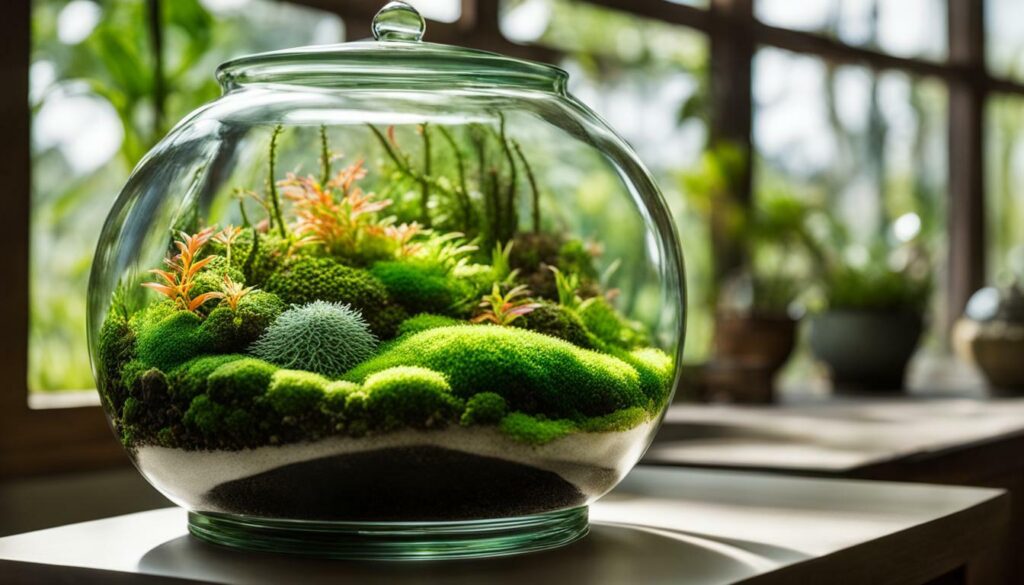
Congratulations on completing the ultimate guide to terrarium plants mosses! By now, you should have a comprehensive understanding of caring for your terrarium plants, selecting the perfect plants and mosses, and designing a visually stunning terrarium landscape. Now, it’s time to put your knowledge into action and create a flourishing green space that brings joy and beauty to your home.
Remember, when selecting terrarium plants, consider the specific needs of each species. Closed terrarium plants thrive in humid environments, so be sure to provide adequate moisture and ventilation. Open terrarium plants, on the other hand, prefer drier conditions, so monitor watering to avoid excessive moisture.
As you design your terrarium landscape, experiment with different combinations of plants to create a visually appealing arrangement. Consider the textures and heights of the plants to add depth and interest to your terrarium. Don’t forget to incorporate the right terrarium moss to enhance the aesthetic appeal and provide a natural habitat for your plants.
Lastly, ensure proper care for your terrarium plants by following the guidelines discussed in the guide. Pay attention to substrate choice, watering schedule, humidity levels, lighting, ventilation, and pest prevention. By providing the ideal conditions and care, your terrarium plants will thrive and bring life and vibrancy to your living space.
How Can I Care for Desert Plants in a Terrarium Similar to Mosses?
When caring for desert plants in a terrarium similar to mosses, it’s important to choose the ultimate desert terrarium plants. Ensure they receive adequate sunlight and minimal water, as they thrive in arid conditions. Choose plants like cacti, succulents, and air plants to create a beautiful desert terrarium.
FAQ
What are closed terrarium plants?
Closed terrarium plants are tropical species that thrive in humid conditions. They are ideal for enclosed terrariums where moisture levels are high.
What are open terrarium plants?
Open terrarium plants are arid species that prefer low moisture environments. They are suitable for terrariums with good ventilation and lower humidity levels.
Where can I find terrarium plants for sale online?
There are several reputable online sources where you can find terrarium plants for sale. Some popular options include specialized terrarium plant retailers and online marketplaces.
How do I care for terrarium plants?
Terrarium plant care involves choosing the right substrate, ensuring proper watering and humidity levels, providing adequate lighting, ventilation, and preventing mold, algae, and pests.
What are the best types of terrarium moss?
The best types of terrarium moss depend on personal preference and the desired visual effect. Common options include sheet moss, pillow moss, mood moss, and cushion moss.
Where can I buy terrarium moss?
You can find terrarium moss at various garden centers, nurseries, and online retailers that specialize in terrarium supplies. It’s important to ensure the moss is sourced from reputable sellers.
How do I prevent condensation in my terrarium?
To prevent condensation in your terrarium, ensure proper ventilation, avoid overwatering, and maintain balanced humidity levels. Placing a small fan near the terrarium can also help improve air circulation.
What are some tips for designing a terrarium landscape?
When designing a terrarium landscape, consider using a variety of terrarium plants with different textures and heights. Create focal points and visually appealing arrangements to enhance the overall aesthetic.
How do I care for terrarium plants as a beginner?
As a beginner, follow the care tips provided in this guide, such as choosing easy-to-care-for plants, maintaining proper lighting and humidity, and monitoring water levels. Start with low-maintenance options until you gain more experience.

